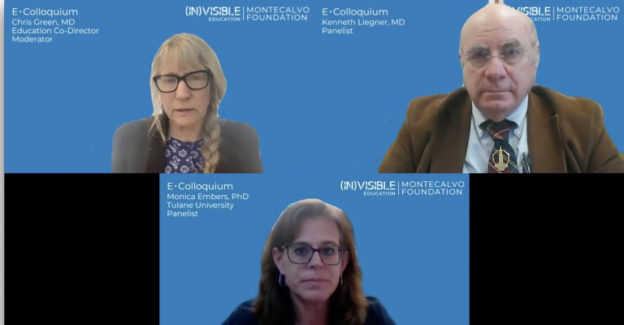Panel participants
Christine Green, MD
Invisible International
Monica Embers, PhD
Tulane National Primate Research Center
Tulane University
Kenneth Liegner, MD
Summary
Invisible International’s Christine Green, MD brings together Monica Embers, PhD (“bench”) and Kenneth Liegner, MD (“bedside”) in a discussion about borrelia persistence.
Bench-to-Bedside E-Colloquium Education Platform
Scientists working in labs and clinicians often lack the opportunities to share their experiences on the diseases that they treat and study. Invisible International is bridging the gap by bringing together these experts in lively, interactive discussions that provide insights into invisible diseases such as long-haul tick-borne illness and COVID-19. These knowledge-sharing events will be held monthly, pending funding, and a web-based archive will provide 24/7 worldwide access to the sessions, annotated with relevant research citations.
Learning Objectives
- Develop an understanding of the basic science discoveries on persistence and immune evasion of the spirochete and how that relates to difficulties in treatment strategies
- Discuss the challenges physicians face when deciding on treatment of chronic Lyme disease
- Consider the following issues that may complicate patient care: Herxheimer reactions and co-infections
This session, Borrelia persistence “Bench to Bedside” E-Colloquium, is approved for 1.0 enduring AAFP Prescribed credit.
AAFP Prescribed credit is accepted by the American Medical Association as equivalent to AMA PRA Category 1 credit(s)™ toward the AMA Physician’s Recognition Award. When applying for the AMA PRA, Prescribed credit earned must be reported as Prescribed, not as Category 1.
The AAFP has reviewed One Health Medical Education for a Changing Climate and deemed it acceptable for AAFP credit. Term of approval is from 01/02/2024 to 01/01/2025. Physicians should claim only the credit commensurate with the extent of their participation in the activity.
Evidence-based bibliography for further study
Caskey, J. R. and M. E. Embers (2015). “Persister Development by Borrelia burgdorferi Populations In Vitro.” Antimicrobial Agents and Chemotherapy 59(10): 6288-6295.
Cheslock, M. A. and M. E. Embers (2019). “Human Bartonellosis: An Underappreciated Public Health Problem?” Trop Med Infect Dis 4(2).
Crossland, N. A., et al. (2018). “Late Disseminated Lyme Disease: Associated Pathology and Spirochete Persistence Posttreatment in Rhesus Macaques.” The American Journal of Pathology 188(3): 672-682.
Elsner, R. A., et al. (2015). “Suppression of Long-Lived Humoral Immunity Following Borrelia burgdorferi Infection.” PLoS Pathog 11(7): e1004976.
Embers, M. E., et al. (2004). “Survival strategies of Borrelia burgdorferi, the etiologic agent of Lyme disease.” Microbes Infect 6(3): 312-318.
Embers, M. E., et al. (2017). “Variable manifestations, diverse seroreactivity and post-treatment persistence in non-human primates exposed to Borrelia burgdorferi by tick feeding.” PLoS ONE 12(12): e0189071.
Gao J, Gong Z, Montesano D, Glazer E, Liegner K. “Repurposing” Disulfiram in the Treatment of Lyme Disease and Babesiosis: Retrospective Review of First 3 Years’ Experience in One Medical Practice. Antibiotics (Basel). 2020 Dec 4;9(12):868. doi: 10.3390/antibiotics9120868. PMID: 33291557; PMCID: PMC7761882.
Liegner KB, Shapiro JR, Ramsay D, Halperin AJ, Hogrefe W, Kong L. Recurrent erythema migrans despite extended antibiotic treatment with minocycline in a patient with persisting Borrelia burgdorferi infection. J Am Acad Dermatol. 1993 Feb;28(2 Pt 2):312-4. doi: 10.1016/0190-9622(93)70043-s. PMID: 8436647.
Liegner KB. Lyme disease: the sensible pursuit of answers. J Clin Microbiol. 1993 Aug;31(8):1961-3. doi: 10.1128/jcm.31.8.1961-1963.1993. PMID: 8370722; PMCID: PMC265679.
Liegner K.B., Duray P., Agricola M., Rosenkilde C., Yannuzzi L., Ziska M., Tilton R.C., Hulinska D., Hubbard J., Fallon B.A. Lyme Disease and the Clinical Spectrum of Antibiotic-Responsive Chronic Meningoencephalomyelitides. J. Spirochetal Tick Borne Dis. 1997;4:61–73.
Liegner KB. Disulfiram (Tetraethylthiuram Disulfide) in the Treatment of Lyme Disease and Babesiosis: Report of Experience in Three Cases. Antibiotics (Basel). 2019 May 30;8(2):72. doi: 10.3390/antibiotics8020072. PMID: 31151194; PMCID: PMC6627205.
Sharma, B., et al. (2015). “Borrelia burgdorferi, the causative agent of Lyme disease, forms drug-tolerant persister cells.” Antimicrobial Agents and Chemotherapy.Miklossy, J. (2011). “Alzheimer’s disease – a neurospirochetosis. Analysis of the evidence following Koch’s and Hill’s criteria.” Journal of Neuroinflammation 8: 90.
Tracy, K. E. and N. Baumgarth (2017). “Borrelia burgdorferi Manipulates Innate and Adaptive Immunity to Establish Persistence in Rodent Reservoir Hosts.” Front Immunol 8: 116.


